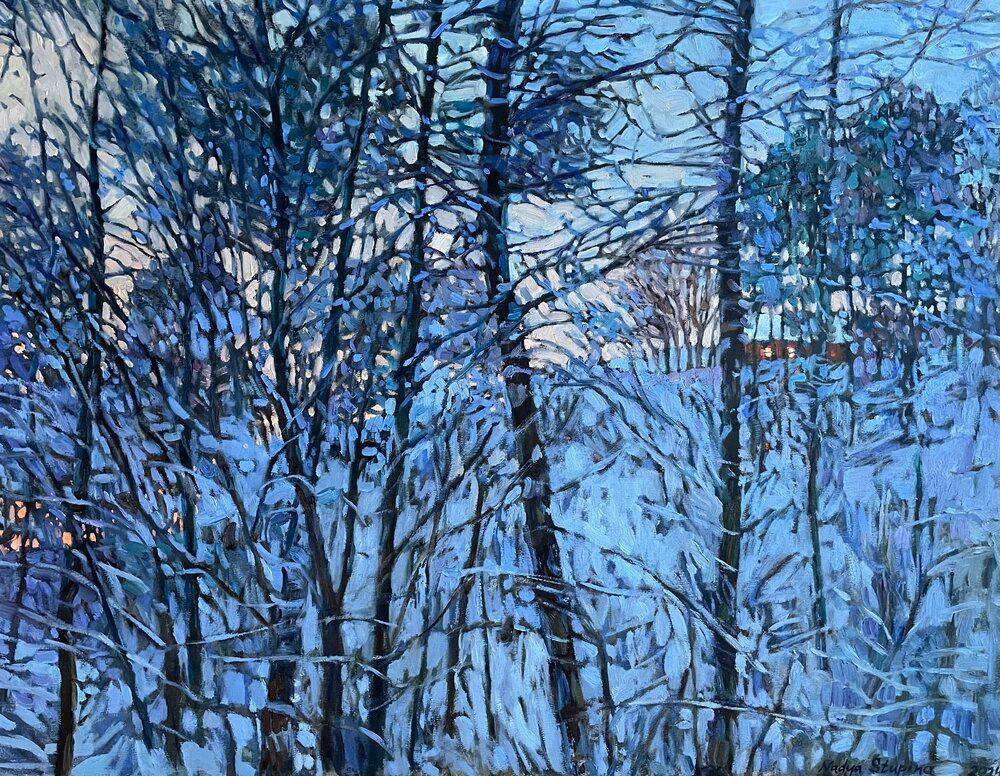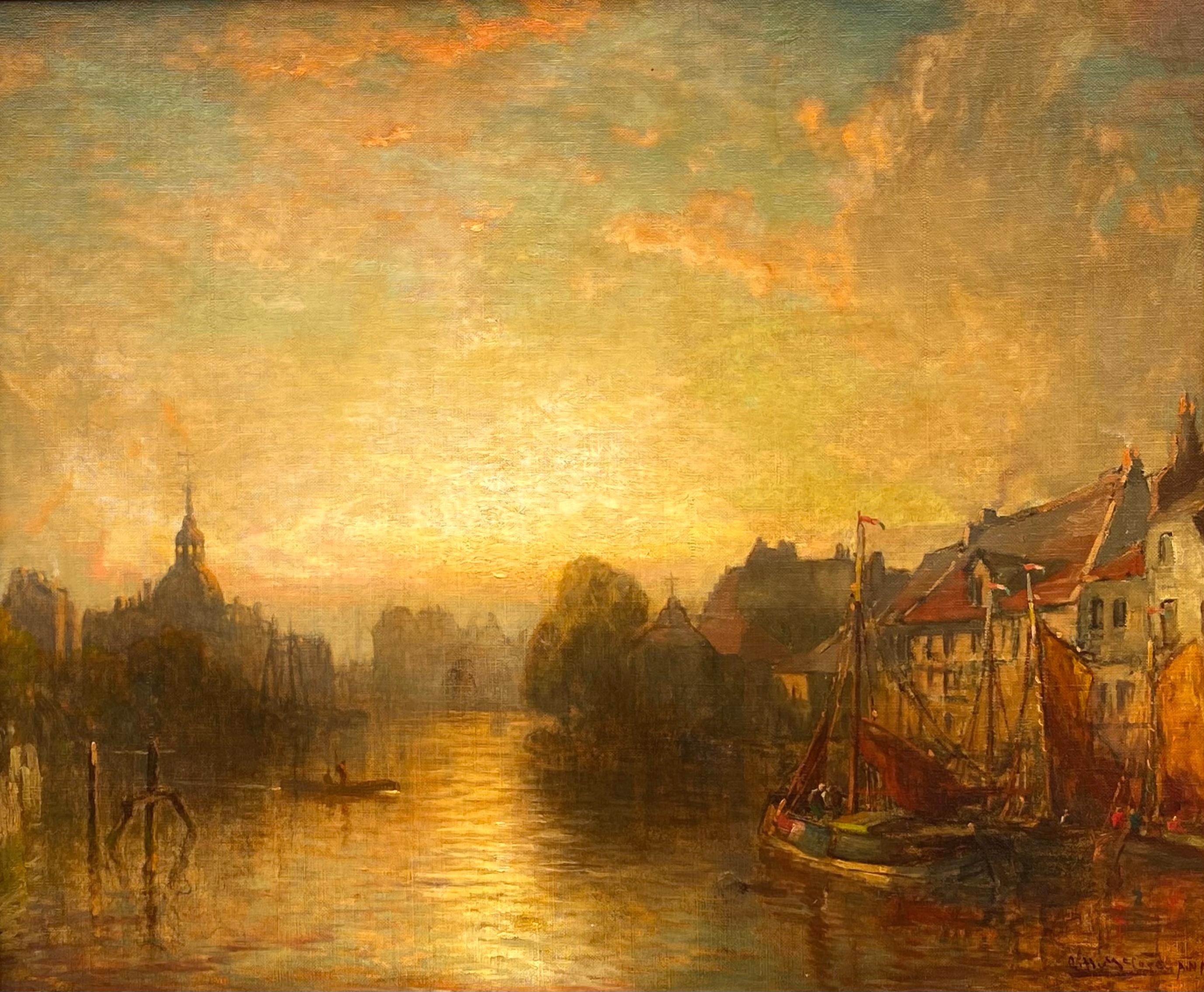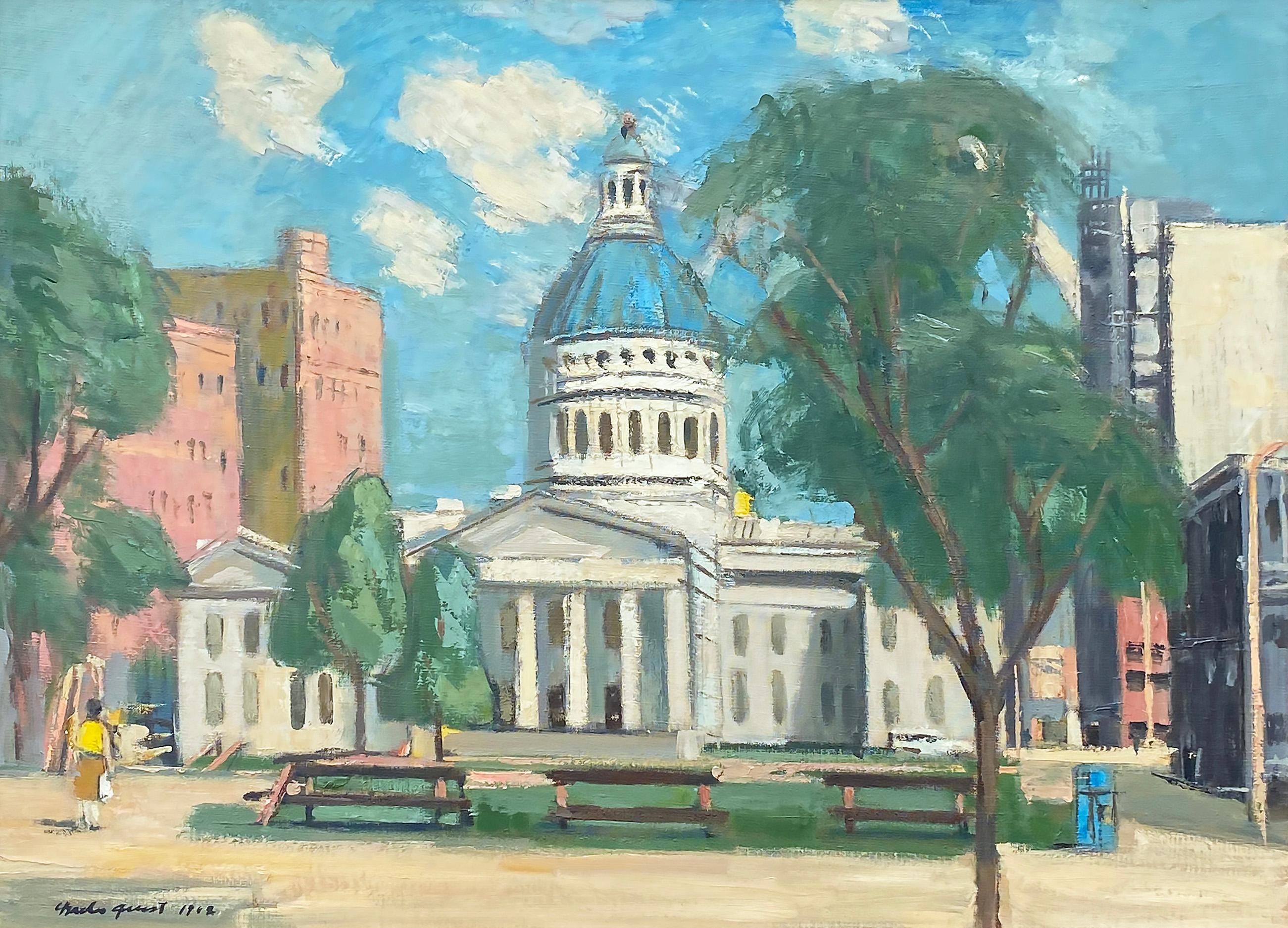Items Similar to 'Clair de Lune sur la Mer' by Alfred Stevens (Brussels 1823 – 1906 Paris)
Video Loading
Want more images or videos?
Request additional images or videos from the seller
1 of 21
Alfred Stevens'Clair de Lune sur la Mer' by Alfred Stevens (Brussels 1823 – 1906 Paris)1892
1892
About the Item
Stevens Alfred
Brussels 1823 – 1906 Paris
Belgian Painter
'Clair de Lune sur la Mer'
Signature: Signed lower right and dated 92
Medium: Oil on canvas
Dimensions: Image size 81 x 65 cm, frame size 97,50 x 81,50 cm
Provenance:
- Collection M. Klein, 1900 - Galerie Petit, Paris, 18 June 1926, nr. 22 - Private collection, Europe - De Vuyst, Belgium, 1998 - Galerie Kuppermans, Amsterdam - Private collection
- The Netherlands Exhibition - Exposition de l'oeuvre d'Alfred Stevens, Palais des Beaux Arts, Brussels, 1928
- Retrospective Alftred Stevens, Ecoile des Beaux Arts, Paris 1900, nr. 100
Literature:
- Alfred Stevens, Francois Boucger, Ed. Rieder Paris 1930, illustrated on page 36
- Documentation by Mrs Christiane Lefebre, 1998
Biography:
Alfred Émile Léopold Stevens (11 May 1823 – 24 August 1906) was a prominent Belgian painter renowned for his depictions of elegant modern women. His works, characterized by a realistic style and meticulous attention to detail, reveal the influence of 17th-century Dutch genre painting. While he initially gained attention for his social realist portrayal of the hardships faced by impoverished vagrants, he later achieved great critical and popular success with his portrayals of upper-middle class Parisian life. Notably, he often used the same models repeatedly, with some of them being identified in the infamous Book of the Courtesans, a confidential surveillance file maintained by the Paris vice squad, as noted by author Summer Brennan.
Stevens was born in Brussels, into a family deeply connected with the visual arts. His older brother Joseph (1816–1892) and his son Léopold (1866–1935) were both painters, while his other brother Arthur (1825–1899) was an art dealer and critic. His father, a veteran of the Napoleonic wars under the army of William I of the Netherlands, was an art collector with a notable collection of watercolors by Eugène Delacroix and other esteemed artists. Stevens’s upbringing was influenced by the environment of Café de l’Amitié, run by his maternal grandparents in Brussels, which served as a meeting place for prominent figures from the political, literary, and artistic spheres. Following the death of his father in 1837, Stevens left middle school to enroll at the Académie Royale des Beaux-Arts in Brussels. There, he came under the tutelage of François Navez, a Neo-Classical painter and former student of Jacques-Louis David, who was both the director of the academy and an old acquaintance of Stevens’s grandfather. Following a traditional curriculum, he initially drew from casts of classical sculptures and later transitioned to drawing from live models. In 1843, Stevens journeyed to Paris to join his already established brother, Joseph. He gained admission to the École des Beaux-Arts, the preeminent art school in Paris, although claims of him being a student of the director, Jean Auguste Dominique Ingres, are likely unfounded. One of his early works, The Pardon or Absolution (Hermitage, St. Petersburg), signed and dated 1849, showcased his mastery of a conventional naturalistic style influenced by 17th-century Dutch genre painting.
Stevens’s work was first publicly exhibited in 1851, when three of his paintings were featured at the Brussels Salon. He received a third-class medal at the Paris Salon in 1853, followed by a second-class medal at the Universal Exposition in Paris in 1855. His painting Ce qu’on appelle le vagabondage [What is called vagrancy] (Musée d’Orsay, Paris) garnered attention from Napoleon III, leading to a change in policy regarding the use of soldiers to remove the poor from the streets. Two other paintings displayed at the Salon in Antwerp in the same year, Chez soi or At Home and The Painter and his Model, introduced subjects from “la vie moderne” that became characteristic of his oeuvre: elegant young women dressed in contemporary fashion and artists in their studios. In 1857, Stevens made his first significant sale to a private collector when Consolation was purchased for a rumored 6,000 francs by the Berlin collector and dealer Ravéné. He and his brother also became part of the artistic milieu in Paris, frequenting salons hosted by Princess Mathilde and popular cafes, where they mingled with the likes of the Goncourt brothers, Théophile Gautier, and Alexandre Dumas. Stevens married Fanny Juliette Albertine Marie Hortense Blanc (1836-1891), a member of a wealthy Belgian family and a long-time acquaintance of the Stevens family, in 1858. The wedding was witnessed by the renowned painter Eugène Delacroix. The couple had four children: Leopold, Jean, Catherine, and Pierre. Stevens depicted his wife in numerous portraits, including Regrets and Memories. After her passing, he expressed enduring grief at her loss. During the 1860s, Stevens rose to considerable acclaim for his paintings of fashionable modern women.
His exhibits at the Salons in Paris and Brussels garnered favorable critical reception and attracted enthusiastic buyers. Notably, his work La Dame en Rose or Woman in Pink (Royal Museums of Fine Arts of Belgium, Brussels), completed in 1866, exemplified a blend of a stylishly attired woman in an interior setting with a detailed exploration of Japanese objects, reflecting his early enthusiasm for Japonisme. In 1863, he was awarded the Legion of Honor (Chevalier) by the French government. In 1867, he secured a first-class medal at the Universal Exposition in Paris, and his rank was elevated to Officer of the Legion of Honor. His social circle included prominent figures such as Édouard Manet, Edgar Degas, Charles Baudelaire, Berthe Morisot, James Abbott McNeill Whistler, Frédéric Bazille, and Puvis de Chavannes, and he was a regular patron of the Café Guerbois in Paris.
Stevens participated in the defense of Paris during the Franco-Prussian War but returned to Belgium with his family before the Paris Commune. They later returned to Paris, where Stevens continued to enjoy critical acclaim and success among collectors. In 1875, he purchased a grand house and garden on rue des Martyrs in Paris, which appeared in his paintings as well as those of other artists, such as Édouard Manet’s The Croquet Party. However, he was forced to vacate the property in 1880 to make way for the construction of a new street, which was eventually named after him. In 1878, he was appointed Commander of the Legion of Honor and was awarded another first-class medal at the Salon.
Despite earning a significant income from the sale of his paintings, Stevens faced financial difficulties during the 1880s due to a combination of poor investments and excessive spending. His financial strain was further compounded by the cost of summer trips to the seaside, which a doctor had advised him to take for health reasons in 1880. Consequently, when the Paris dealer Georges Petit offered him 50,000 francs to finance his vacations in exchange for paintings created during that period, Stevens agreed. This arrangement, spanning three years, resulted in the sea becoming a significant subject in his work, and over the course of his career, he produced numerous views of popular resorts along the Normandy coast and the Midi in the south. Many of these works were executed in a sketchy style influenced by the Impressionists.
Stevens also began teaching private students, including the renowned actress Sarah Bernhardt, who became a close friend, and the American artist William Merritt Chase. Other notable students included Berthe Art, Charles Bell Birch, Jules Cayron, Marie Collart-Henrotin, Louise De Hem, Harriet Campbell Foss, Georgette Meunier, Lilla Cabot Perry, Jean-Paul Sinibaldi, and Fernand Toussaint. The most significant work from the latter part of Stevens’s career was the monumental Panorama du Siècle, 1789–1889, which he painted in collaboration with Henri Gervex. In this project, Stevens painted the women and intricate details, while Gervex focused on the male figures, with the assistance of fifteen assistants. The painting garnered significant acclaim when it was exhibited at the International Exhibition in Paris in 1889.
Stevens received several notable tributes during his lifetime. In 1895, a large exhibition of his work was held in Brussels, followed by a retrospective exhibition at the Ecole des Beaux-Arts in Paris in 1900, marking the first retrospective dedicated to a living artist by the institution. Supported by patrons led by the Comtesse de Greffulhe, the exhibition achieved both social prestige and widespread acclaim. In 1905, Stevens was the only living artist featured in a retrospective exhibition of Belgian art in Brussels. Despite these accolades, he struggled to sell enough of his work to alleviate his financial difficulties. Having outlived his brothers and the majority of his friends, Stevens passed away in Paris in 1906, residing alone in modest accommodations while remaining in touch with his four children.
- Creator:Alfred Stevens (1823 - 1906)
- Creation Year:1892
- Dimensions:Height: 38.39 in (97.5 cm)Width: 32.09 in (81.5 cm)Depth: 3.94 in (10 cm)
- Medium:
- Movement & Style:
- Period:
- Condition:The artwork is elegantly displayed within a high-quality frame, impeccably preserved in its excellent condition. This piece is presented in a state suitable for immediate gallery hanging, having undergone professional cleaning and review.
- Gallery Location:Bruges, BE
- Reference Number:1stDibs: LU2006213599852
About the Seller
5.0
Vetted Seller
These experienced sellers undergo a comprehensive evaluation by our team of in-house experts.
Established in 1998
1stDibs seller since 2022
14 sales on 1stDibs
Typical response time: 1 to 2 days
- ShippingRetrieving quote...Ships From: Bruges, Belgium
- Return PolicyA return for this item may be initiated within 14 days of delivery.
More From This SellerView All
- A Landscape with Two Roosters, Hoess Eugen Ludwig, 1866 – 1955, German PainterLocated in Bruges, BEA Landscape with Two Roosters Hoess Eugen Immenstadt 1866 – 1955 Langenwang German Painter Signature: Signed bottom right and dated 27 Medium: Oil on canvas Dimensions: Image size 72 x 94 cm Biography: Hoess Eugen Ludwig was born in 1866 in Immenstadt, Germany. He was a painter of landscapes and hunting scenes. He painted not only oil paintings but also watercolours and made etchings. Hoess passed the entrance examination at the Academy of Fine Arts in Munich. He was a student of master teachers and artists Kirchbach, Raupp, v. Hackl and Ritter v. Herterich. In 1889 he moved to Frankfurt and in 1891 he returned to Munich. In 1898 he went on study trips to Sweden, Austria and Italy and returned to his hometown. Two years later he had his first exhibition in Munich with paintings of hunting scenes...Category
Early 20th Century Impressionist Landscape Paintings
MaterialsCanvas, Oil
- Hunting in Fontainebleau, Georges Stein, Paris 1870 – 1955, French PainterLocated in Bruges, BEHunting in Fontainebleau, France Stein Georges Paris 1870 – 1955 French Painter Signature: Signed bottom left and placed Fontainebleau Medium: Oil on c...Category
Late 19th Century Impressionist Landscape Paintings
MaterialsCanvas, Oil
- A Pair of Swans, Leonie Arden, Antwerp 1859 – 1904 Brussels, Belgian, SignedLocated in Bruges, BEA Pair of Swans Leonie Arden Antwerp 1859 – 1904 Brussels, Belgian Painter Signature: Signed bottom right Medium: Oil on canvas Dimensions: Image size 21,5 x 27 cm, frame size 28 x...Category
19th Century Impressionist Animal Paintings
MaterialsCanvas, Oil
- Jean-Baptiste Degreef, 1852 – 1894, A Pond in the Park – Chateau of Val-DuchesseLocated in Bruges, BEVal Duchesse Castle (Dutch: Kasteel Hertoginnedal) is located in the municipality of Auderghem, in the south of Brussels (Belgium), on the edge of the Soignes Forest. The Val Duchess...Category
Late 19th Century Impressionist Landscape Paintings
MaterialsCanvas, Oil
- A Little Farmhouse, Georges De Sloovere, Bruges 1873 – 1970, Belgian PainterLocated in Bruges, BEA Little Farmhouse De Sloovere Georges Bruges 1873 – 1970 Belgian Painter Bruges School Signature: Signed bottom left Dimensions: Image size 71 x 60 cm, frame size 81 x 70 cm Mediu...Category
Early 20th Century Impressionist Landscape Paintings
MaterialsCanvas, Oil
- Wind Mills Along the Canal, Mijndert Van Den Berg, 1876 – 1967, Dutch PainterLocated in Bruges, BEWind Mills Along the Canal Van Den Berg Mijndert Gorinchem 1876 – 1967 The Hague Dutch Painter Signature: Signed bottom left Medium: Oil on canvas Dimensions: Image size 30 x 50 cm...Category
20th Century Impressionist Landscape Paintings
MaterialsCanvas, Oil
You May Also Like
- Cape Cod Harbor SceneBy Kristina NemethyLocated in New York, NYA stunning depiction of boats docked in a Cape Cod harbor. Nemethy uses a bold impressionistic technique with thick use of paint and wonderful impressi...Category
2010s Impressionist Landscape Paintings
MaterialsOil, Board, Canvas
- Winter lace 2Located in Oslo, NOIn crafting this piece, I immersed myself in the serene yet vibrant essence of winter. Through impressionistic strokes in oil, I aimed to capture the intricate dance of light and sha...Category
2010s Impressionist Landscape Paintings
MaterialsCanvas, Oil, Acrylic
- "Best Of Times", John Cook, Oil on Canvas, Impressionism, 60x70 in, Venice ItalyBy John CookLocated in Dallas, TX"Best of Times" is an original oil on canvas and measures 60x70 inches. Cook shows his passion for capturing natural beauty in this Italian landscape of Venice, Italy. The impression...Category
Early 2000s Impressionist Landscape Paintings
MaterialsCanvas, Oil
- “Amsterdam Harbor at Sunset”By George McCordLocated in Southampton, NYVery well executed tonalist work of a sunset over Amsterdam Harbor in Holland by the well known American artist, George McCord. Signed lower right with A.N.A following the signature which stands for Associate of the National Academy. Circa 1890. Condition is good. The painting is oil on canvas (relined) and is housed in an semi-antique style gold ornate frame. Frame is in very good condition. Overall framed measurements are 30 by 35 inches. Provenance: A Sarasota, Florida estate. GEORGE HERBERT McCORD (1848-1909) Born on August 1, 1848 in Manhattan, New York, George Herbert McCord was considered a central figure of the second generation Hudson River painters. While McCord described himself as mostly self-taught, he attended the Hudson River Institute and the Claverack Academy in New York. He also spent time studying in the studios of Samuel Morse...Category
1880s Impressionist Landscape Paintings
MaterialsOil, Canvas
- The Old CourthouseBy Charles QuestLocated in Missouri, MOThe Old Courthouse, 1968 By. Charles Quest (American, 1904-1993) Signed and Dated Lower Left 32 x 44 inches 38.25 x 50.25 inches with frame Born in Troy, New York, Charles Quest was...Category
20th Century American Impressionist Landscape Paintings
MaterialsCanvas, Oil
- After Rain, Landscape, Original oil Painting, Ready to HangBy Vahe YeremyanLocated in Granada Hills, CAArtist: Vahe Yeremyan Work: Original Oil Painting, Handmade Artwork, One of a Kind Medium: Oil on Canvas Year: 2024 Style: Impressionism, Subject: After Rain Size: 13.5" x 17.5" ...Category
2010s Impressionist Landscape Paintings
MaterialsCanvas, Oil



